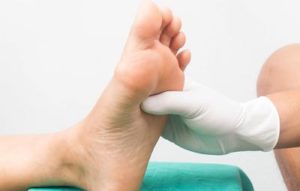
Recently Diagnosed or Relapsed? Stop Looking For a Miracle Cure, and Use Evidence-Based Therapies To Enhance Your Treatment and Prolong Your Remission
Multiple Myeloma an incurable disease, but I have spent the last 25 years in remission using a blend of conventional oncology and evidence-based nutrition, supplementation, and lifestyle therapies from peer-reviewed studies that your oncologist probably hasn't told you about.
Click the orange button to the right to learn more about what you can start doing today.
- You are here:
- Home »
- Blog »
- Multiple Myeloma »
- Chemotherapy-Induced Peripheral Neuropathy in Multiple Myeloma
Chemotherapy-Induced Peripheral Neuropathy in Multiple Myeloma

Multiple Myeloma patients prevalently describe numbness/tingling in hands and feet, burning pain, altered sensitivity to touch and heat, muscle weakness, skin or nail changes, and/or lack of coordination.
As the saying goes, “the cure is worse than the disease.” In this case, the cure is chemotherapy for multiple myeloma. While chemotherapy can manage your multiple myeloma for a time, side effects such as chemotherapy-induced peripheral neuropathy (CIPN) can be severe, lowering chemo dosages or even requiring the discontinuation of therapy completely.
In my case I underwent both several courses of radiation as well as high-dose chemotherapy. I have been diagnosed with both radiation-induced peripheral neuropathy as well as CIPN.
The bottom line is that nerves are heavily damaged…
I am posting and excerpting the article below knowing that you are probably already suffering from this debilitating side effect. The therapies listed below are considered to be “supportive care” rather than “preventive care.”
I am both a long-term MM survivor and MM cancer coach. Experience has taught me that the sooner you begin evidenced-based supportive care therapies discussed below, the better chance you have of addressing your CIPN.
I have lived in complete remission from my MM since ’99 by living the therapies discussed in the MM Cancer Coaching program. Scroll down the page to post a question or comment if you would like.
Thank you,
David Emerson
- MM Survivor
- MM Cancer Coach
- Director PeopleBeatingCancer
Recommended Reading:
The PeopleBeatingCancer Side Effects Program
Managing Treatment-related Peripheral Neuropathy in Patients with Multiple Myeloma
“SIGNS AND SYMPTOMS- Patients prevalently describe numbness/tingling in hands and feet, burning pain, altered sensitivity to touch and heat, muscle weakness, skin or nail changes, and/or lack of coordination. In fact, sensory neuropathy and neuropathic pain are more common; therefore, hyperesthesia, hypoesthesia, and paresthesia are very often referred, usually in a distal stocking-and-glove distribution over the hands and feet, frequently associated with altered heat and cold sensation…
TREATMENT-RELATED PN-Treatment-related PN depends on the drug used, the dosage, and the cumulative dose administered; it is usually symmetric and distal and dramatically affects the quality of life of patients, leading frequently to dose reduction, delay, or even discontinuation of a successful treatment…
Thalidomide-TiPN is mainly a sensory axonal polyneuropathy that can also occur at the end of treatment, which is cumulative,dose-dependent, and often irreversible..
The incidence of TiPN reported in the literature is extremely variable, from 23% to 70%, according to the study, the population analyzed (pretreated or naïve patients), and the length of exposure and dosage;42,43, however, the majority of studies report PN in one-third or half of the treated patients.44,45 The risk of neurotoxicity increases in a dose-dependent manner up to a cumulative dose of 20 g…
Bortezomib-BiPN generally starts distally and may progress proximally; it is related to dose, schedule, and mode of administration and is usually reversible…
As supportive care, vitamin B, antioxidants such as vitamin E, alpha-lipoic acid, glutathione, and supplements with glutamine or acetyl-1-carnitine can be used. However, administration of pyridoxine (vitamin B6) can cause additional sensory neuropathy in patients with impaired renal function and in association with a protein-deficient diet; vitamin C may interfere with bortezomib metabolism and may also abrogate bortezomib-mediated inhibition of proteasome activity. Therefore, careful attention is recommended, especially during the days of bortezomib administration. The drugs to alleviate BiPN include gabapentin or pregabalin; tricyclic antidepressants such as amitriptyline, nortriptyline, and imipramine; serotonin and norepinephrine reuptake inhibitors; carbamazepine; and opioid-type analgesics. The local application of lidocaine or menthol-containing analgesic cream can temporarily alleviate bortezomib-induced pain.
Some authors propose first to use pregabalin (150–600 mg/d) for at least 3 months or gabapentin (300–2,400 mg/d). In case of failure, duloxetine (30–60 mg/d) is considered as a valid second-line choice. Tramadol can reduce chronic pain.38
However, the recommendations from the British Committee for Standards in Haematology in MM are
- oral tramadol for mild-moderate pain;
- oral oxycodone or alternatively morphine for chronic moderate-severe pain; and
- SC opioid therapy (oxycodone or morphine injection) for acute severe pain.104,105
Moreover, patients should be advised to:
- wear loose-fitting shoes, roomy socks, and padded slippers;
- soak feet in icy water and massage the feet for temporary pain relief;
- keep feet uncovered in bed because pressing on the toes can add to the problem; and
- walk to help circulation in the feet, even if too much walking or standing can make the problem worse.
Patients suffering from severe PN and having difficulty in the execution of daily activities can benefit from physical exercise and physiotherapy. Adequate fiber and fluid intake, stool softeners, and laxatives are recommended for the prevention of treatment-induced constipation (and also to avoid side effects of painkillers). Patients with autonomic dysfunctions should rise cautiously, avoid demanding physical tasks, and drive vehicles or operate machinery with caution; hydration, adjustment of antihypertensive medications, increased salt intake, and eventually, low-dose mineralocorticoids can be helpful for orthostasis.28,29,38,41,105 More recently, menthol, a topical transient receptor potential melastatin 8 receptor activator, seems to be efficient for BiPN.106 “


